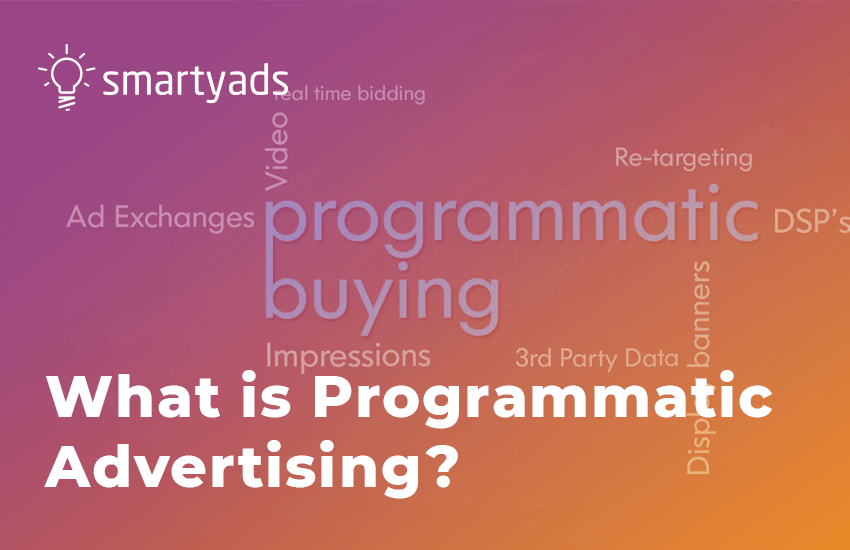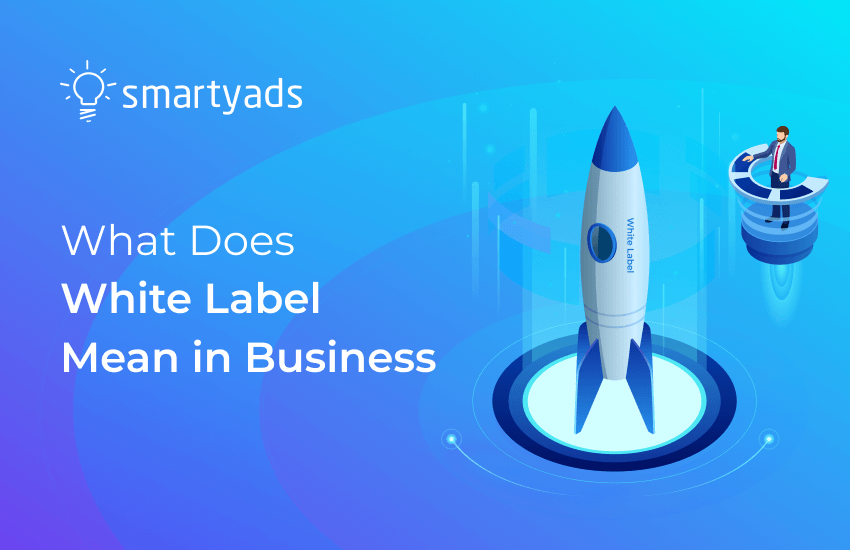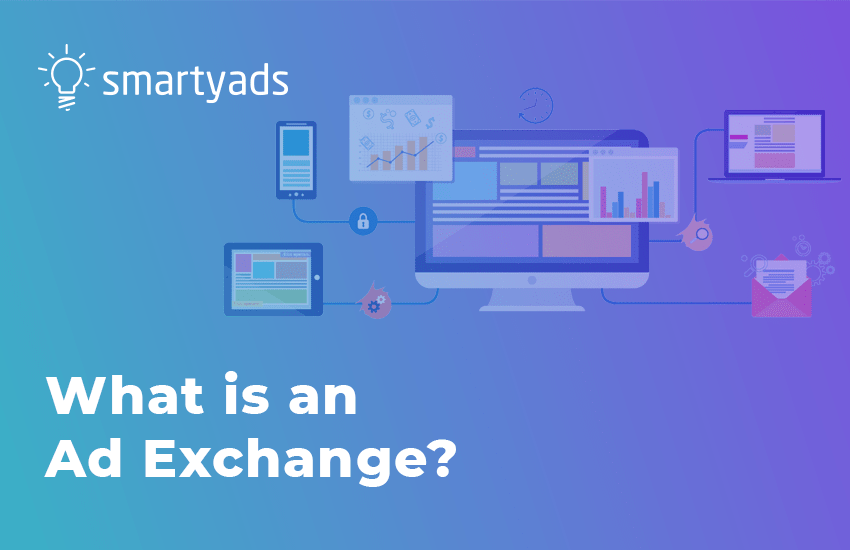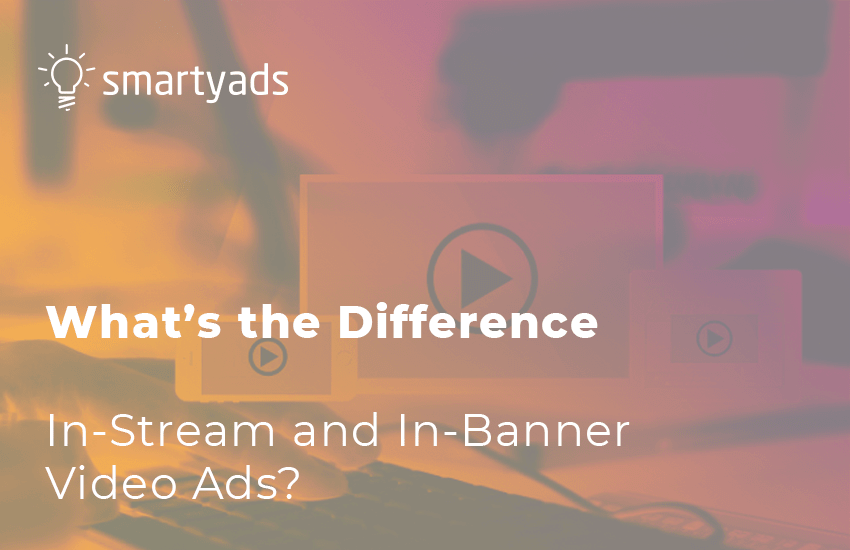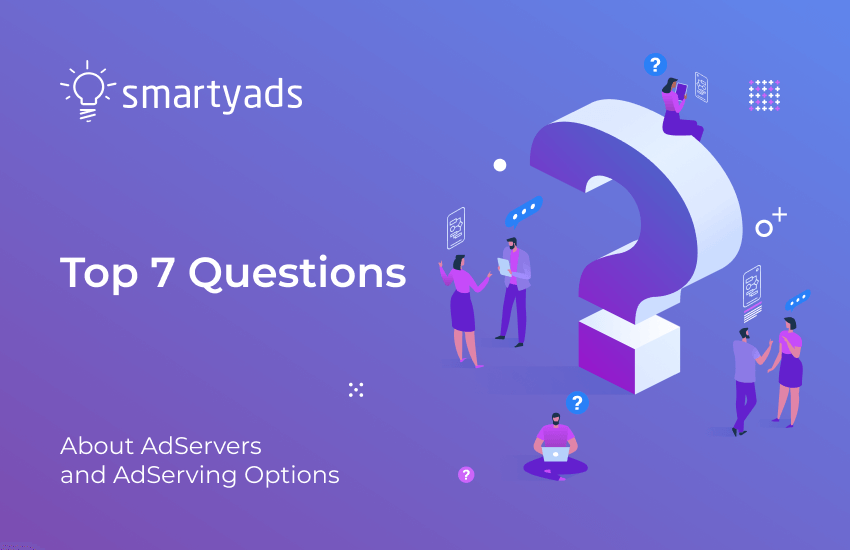Programmatic Advertising (sometimes also referred to as Programmatic Marketing or Programmatic Buying) is an automated process of buying and selling a digital ad inventory across a wide range of websites. Being exclusive only to digital display advertising and search ads in the beginning, programmatic now includes many more mediums such as video, mobile, in-app, and social, across different platforms and channels.
Some programmatic buying systems nowadays have access even to traditional TV inventories, making their way to users’ households. The operation of programmatic advertising is based on artificial intelligence and machine learning algorithms.
Let’s discover what is the definition of programmatic online advertising and find out how it can be differentiated from other types of traditional and digital advertising. Let's find out why it is a good idea to make your advertising programmatic.

What is programmatic advertising?
The term merely means “automated”. Programmatic advertising shouldn’t be confused with real-time bidding since RTB is just one of the possible media buying methods. In fact, the purchasing of mobile and display ads is not only possible with real-time bidding RTB auctions, but it may also happen as well through programmatic direct – in this case, the ad inventory is guaranteed or reserved on the fixed terms between the publisher and advertiser.
In a nutshell, programmatic buying is any ad purchase that involves machine and software processing which automatically buys and fills advertising space. With this, the advertiser can buy ad on a per-impression CPM or CPC basis.
Programmatic advertising always implies the use of multi-sourced data involving real-time bidding systems, formulas, and algorithms to automate the delivery of data-driven, personally-tailored, and relevant experiences to consumers as they interact with the brand across multiple touchpoints.
Such experiences include targeted offerings, messages, and content across paid, owned, and earned channels.
How programmatic redefined traditional ad buying
Programmatic digital marketing, as opposed to traditional display advertising buying that, involves RFT (request for proposal), human negotiation, manual insertion of orders, invoicing, and payment.
With programmatic advertising, the ad buying, placement, and optimization are executed by machine learning algorithms, making the process time-efficient and cheaper, eliminating inconsistency and human errors.
Although it may seem that programmatic technology excludes humans from the process of digital media ad buying, in reality, it is not really so. In fact, programmatic advertising still heavily relies on people, who customize campaigns and adjust settings to get the most out of it.
Is programmatic different from contextual advertising?
Top vs bottom of the funnel. Yes, even though contextual advertising also automates digital advertising it has different targeting mechanisms. Contextual advertising works mostly with already established user needs, in other words with consideration of the customer’s journey.
This is why contextual ads are based on commercial keywords like e.g “buy the car”, “cheapest cars in New Jersey”, “food delivery service”, and so on. Users type these keywords in search and find the product or service they want. As well, contextual advertising can be placed on websites that have similar thematics to the product - like sportswear ads near the sport-related news feeds.
Programmatic advertising, meanwhile, works at the top of the funnel. It works with branding campaigns - creates the need and leads the client to the purchasing. Contextual ads are only bound to certain thematic websites.
Targeting in programmatic advertising singles out only those users whose data matches selected campaign criteria (age, gender, geo, etc.), so these ads can appear on every website.
If the user didn’t convert, the programmatic advertising platform can also return them to the site with a retargeting feature.
Programmatic advertising and personalization
Targeting users instead of websites. Just as mentioned above, unlike contextual ads programmatic advertising doesn’t target websites across particular thematics. Instead, it targets only particular users whose data corresponds to the notion of the “target audience”.
This, in turn, allows advertisers to achieve much better precision when it comes to experience personalization. User data is at the core of such personalization. This is why many brands prefer to turn their advertising programmatic.
Finding the right user at the right time
As known, any user action on the Internet leaves digital footprints. With the help of cookies, websites, and apps gather, collect, and store such information about the users. This information helps to streamline the website experience each time a user visits the same web source again.
At the same time cookies can be useful for showing up personal recommendations enabled by personal targeting. This is the fuel of programmatic advertising.
Thus, using search history on websites, history in search engines, and purchasing preferences stored in cookies and other data, the programmatic advertising system can create a full-fledged digital portrait of the user according to which the system will serve the ads.
The role of programmatic in online advertising
These days the majority, 83.5% of companies in the U.S are using programmatic advertising technologies to buy ad space online according to eMarketer. It is $57.30 billion US dollars yearly. Half of this money is distributed to social media ads that enable automatic ad campaigns planning, optimization, and analysis.
Google and Facebook are still the most influential ad tech players because they have access to the most valuable advertising asset - user data. Together with Amazon, Facebook and Google account for at least 50% of the programmatic advertising market.
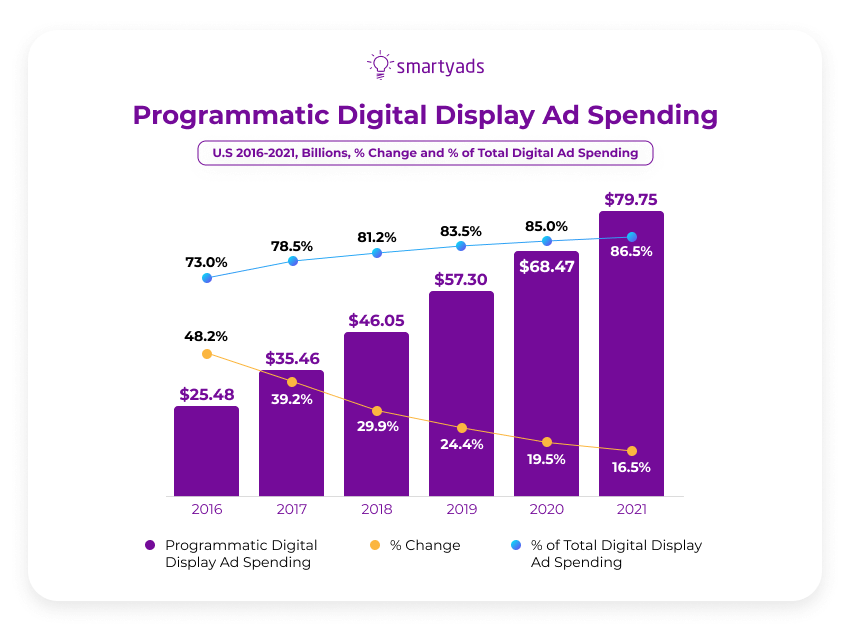
Programmatic market share
When it comes to digital ad formats there are different types that currently gain traction in programmatic advertising. For instance, videos are becoming increasingly popular due to the broad adoption of Connected TV advertising. In fact, one out of ten dollars spent programmatically goes to CTV medium.
Emarketer also reports that it is expected that by 2021 CTV ad medium will take the majority of video ad spending away from the desktop.
Plus, the programmatic advertising ad spending by this time will reach an unprecedented $6.26 billion. That’s when the programmatic on CTV will make 15.9% of the total programmatic video. On laptops and desktop mediums popular video format will only account for 9.9% of total spending.
Popular digital ad formats
The other popular ad formats in programmatic advertising include banners, natives, rich media, and audio (the rising star). The banner is a very affordable format and can be supported by almost all environments and devices. Thanks to the new programmatic capabilities the audio ads find their listeners on streaming services, radio, and podcasts.
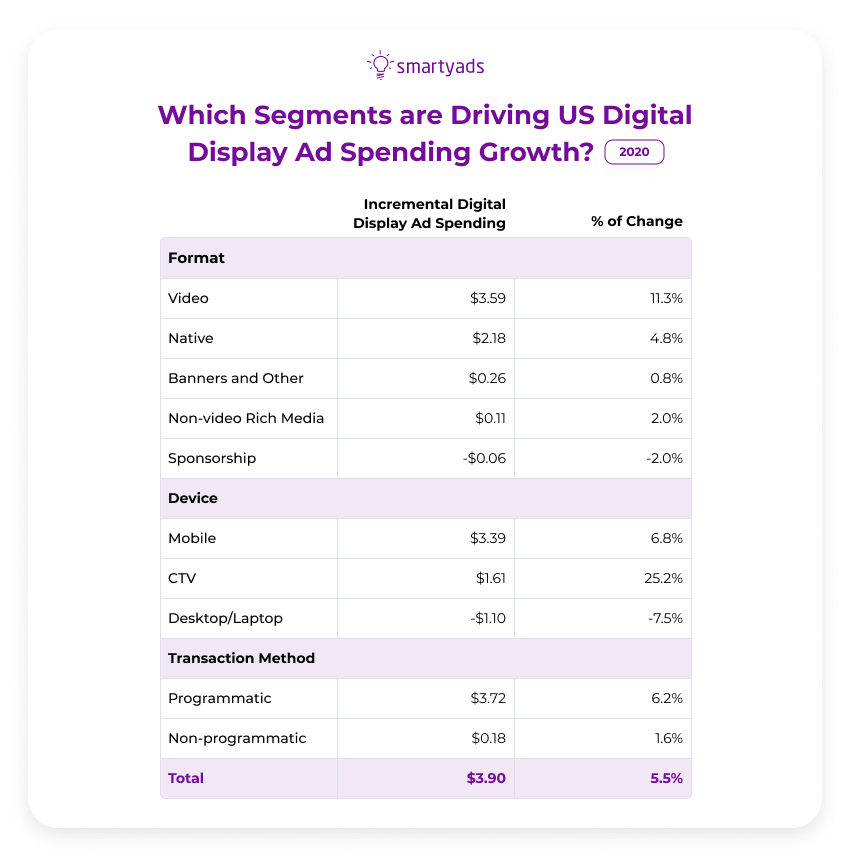
Benefits of Programmatic Advertising
Buying targeted audiences instead of ad slots. There are several benefits of programmatic advertising and audience targeting is the most important. Traditional digital marketing and display advertising purchasing focus on delivering to specific websites where they can be seen by random users. Basically, advertisers buy the ad placement and receive a guarantee from the publishers that their ads will be placed on particular pages during a particular period.
On the contrary, programmatic advertising is not bound to certain ad slots on certain websites. It can show ads on any given website (connected to programmatic) and the decision of whether to show the ad to the user or not will depend on the relevance of user data contained in the cookies.
This way programmatic advertising ensures that ads are relevant to users, regardless of the website they are visiting. Artificial intelligence and machine learning are responsible for this decision-making.
Therefore, programmatic ad buying allows finding potential customers in the environments both inside and outside of thematic niches (while contextual display advertising sticks to thematic niches only). So, it is all about “audience buying” rather than buying digital media.
Automation and precision as key advantages
The automated nature of the programmatic advertising technology (algorithmic ad buying) is what helps to overcome the difficulties of traditional media buying and media-selling. The entire process from the page opening to the ad serving takes less than milliseconds. This way targeting, decision-making, bidding, transaction, and impression delivery are done in the blink of an eye.
Advertisers can spend their marketing budgets more expeditiously, serving display advertising to the audiences, which are most likely to be interested in those programmatic ads. Thus, the demand side can minimize the number of wasted ad impressions, enhancing the overall efficiency of the campaign by exposing an ad to the right person at the right time and context.
Meanwhile, publishers also benefit and maximize the value of their ad space by selling it to the highest bidder in real-time bidding auctions. Publishers aren’t passive and accepting of the system, through the SSP they define what kind of programmatic advertising appears on their web pages (in apps) in terms of content, format, product design, size, and even colors.
By the way, here is the guide to website and blog traffic monetization for publishers.
Cost efficiency:
With programmatic ad buying, advertisers are in charge of how much they are willing to pay for each impression. Since every impression is unique, prices may vary depending on the user, his/her relevance to the targeting settings. Therefore buying one impression at a time is a cost-efficient solution.
For the publishers cost-efficiently lies in the following feature: the SSP helps them to set up the price floors (minimal price per one impression), which, in turn, protects them from potentially disadvantageous deals.
Precise metrics of ad campaigns:
Due to the extremely targeted nature of programmatic advertising, media buyers get a better ability to measure the efficiency of display advertising campaigns by evaluating the lead conversions and the quality of click-through rate (CTR) (learn more about SmartyAds RTB targeting solutions).
Programmatic buying allows tracking of what is bought, at what price, and to whom. Programmatic technology and machine learning allow predicting the performance of future campaigns across different types of formats and mediums: mobile, desktop, CTV.
Scalability of campaigns:
Thanks to programmatic advertising media buyers get access to a large number of impressions available on publishers’ websites all over the world. Programmatic advertising allows reaching a wider audience across multiple websites, platforms, and channels in a timely and efficient manner.

How Does Programmatic Advertising Work?
Major components of the programmatic buying and selling ecosystem are DSPs, SSPs, Ad Exchanges, Ad Servers, and DMPs. Marketers and advertisers use demand-side platform DSP to set the purchasing parameters for ad campaigns. Demand-side platform DSP facilitates the process of buying ad slots on the open market and provides the ability to reach out and find your target audience.
Demand-side platforms
Oftentimes demand-side platform DSP technology has integration with data management platform (also, you can read about DSP features is and how the DSP works). Data management platforms collect and evaluate a massive amount of cookie info to provide marketers with a clearer picture of their audience and help to make more informed decisions when targeting. A data management platform may also segment and properly organize data for targeting.
At the same time, a DSP can aggregate data in another way without the help of a data management platform while directly integrating with SSPs.
Supply-side platforms
From the publisher’s perspective, SSPs (supply-side platforms) collect third-party data about the web page viewers such as demographics, location, interests, browsing behavior, etc., and submit this data when listing a publisher’s ad space on an Ad Exchange. They are reverse versions of demand-side platforms but created for publishers.
Ad exchanges will be in charge of selecting the winning bid during the RTB auction and serving the winning banner ad on the publisher’s website. Thus, ad exchanges are in charge of buying and selling since they maintain online real-time auctions.
Ad exchanges
An ad exchange gathers a large pool of available ad inventory that advertisers can buy from a broad list of publishers. It functions on the basis of programmatic advertising as well. An ad Exchange runs real-time auctions based on delivering one impression at a time via RTB.
Ad exchanges send the command to the servers when the winning impression is defined. Ad Servers store ad content that is used in online digital marketing and delivers that content onto various digital programmatic advertising platforms such as desktop websites, mobile, tablet websites, and apps when requested through a URL load.
Ultimately, the programmatic technology unites buyers and sellers of digital ad space in an automated real-time auction. The ad buying and selling process in the programmatic advertising auction is based on the campaign parameters of the advertiser and publisher audiences. Here’s how this digital advertising system works:
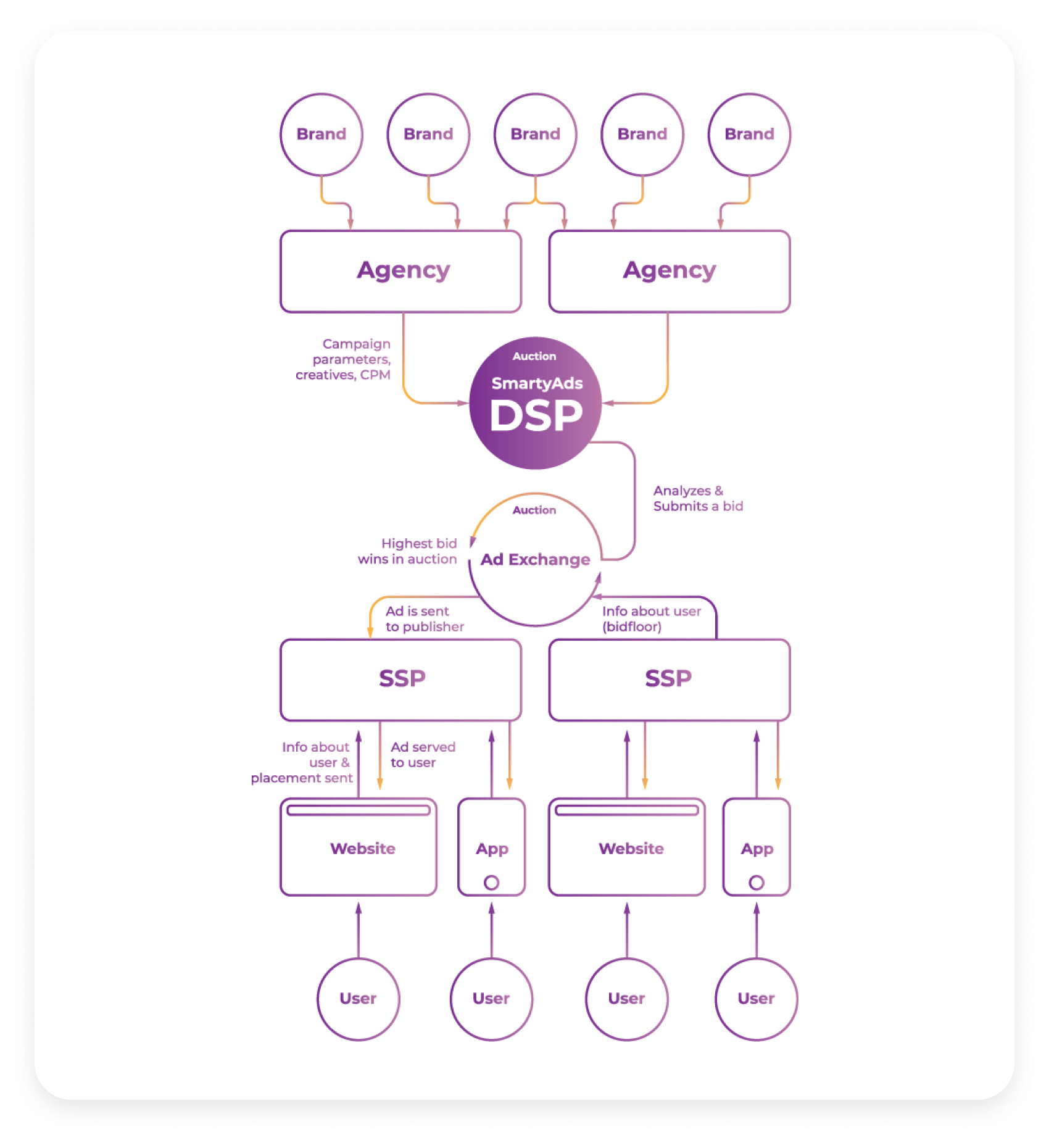
- User visits website or app. The browser collects user data (cookies: IP, geo, browser type, gadget OS, behavioral data).
- Information about the available ad impression is sent to supply-side platform SSP (it helps publishers to sell advertising space programmatically in real-time). Via the supply-side platform SSP, the publisher (website or app owner) sets the bid floor (minimum amount of money a publisher is willing to accept for 1000 programmatic ad impressions).
- The supply-side platform SSP sends a bid request to DSP (allows advertisers to buy programmatic ad inventory) with info about the user collected by the website and info about the bid floor.
- Agencies pre-set campaign parameters (on behalf of brands) on demand-side platform: add creatives, configure frequency capping, set targeting, daily budget spend, and preferable CPM (price for 1,000 advertisement ad impressions), etc. Then the bid on impression goes to ad exchange.
- Auction based on real-time bidding starts on the ad exchange. DSP evaluates impression value: (targeting, budget, +other campaign parameters), makes a bid response on the bid request/impression, and sends it to an ad exchange. Ad exchanges are those technologies responsible for maintaining the real-time auction.
- The real-time auction continues: ad exchange processes the bids from DSPs. The highest bid wins. An ad exchange notifies ad servers about ad delivery.
- Winner’s ad is sent to the publisher and displayed to the targeted user. A programmatic ad impression is served on the ad space.
How do you become a programmatic advertiser?
How to get started with programmatic ads? As an advertiser, you can easily join in programmatic trading after registering on a demand-side platform DSP. After you complete your campaign details and fill in the campaign budget you can download the creative, air your campaign, and automatically bid on suitable ad impressions as soon as creative is approved.
Setting campaign details
Campaign settings in the demand-side platform DSP dashboard are quite extensive and this is exactly what helps to individualize each campaign and suit it for every budget and audience segment. Using DSP guide you can configure targeting options (what people will see your programmatic ads, their age, location, language, OS, device, browser, etc.).
In the same way, the dashboard lets you filter out the publishers, select the budget allocation and limits, frequency of ad impressions, install the tracking pixels, and arrange creatives. In case you want to trade with publishers directly you can configure the publisher’s ID in the campaign settings.
The platform can be used self-serve and as a managed-serve option (which means that campaigns will be configured, optimized, and analyzed by specialized account managers on your behalf).
How do you become a programmatic publisher?
What can you achieve using programmatic as a publisher? Publishers can join the programmatic trading by registering at supply-side platform SSP. If as a publisher you want to sell online ad space directly to the advertiser, bypassing the RTB auctions, you can engage in the direct deals, or you can participate in the private marketplace auctions.
Thus, SSPs work as reverse DSPs and help publishers sell their ad space to the advertisers at the highest price offered by advertisers (in the real-time auctions).
Embrace supply-side platforms
Supply-side platform dashboard also has a lot of functions using which publishers can control how ad campaigns go: the size and location of creatives (on their website/app), who to trade with (filter lists), the price floors for ad space (see more in SSP guide). The publishers don’t pay anything to the programmatic advertising platform providers. They just register and receive the money for every impression served at their ad inventory in real-time.
For this, the website/app has to be approved by the platform (the ad space needs to have an essential number of daily visits).
Best practices of programmatic advertising
While using programmatic you can get several advantages:
Target the right audiences
One of the strategies that can help you to improve the effectiveness of programmatic campaigns is to target display ads according to user segments. To do this, you need to know the portrait of your ideal user: age range, interests, gadgets they use, and channels they stay at. After this configuring your campaign won’t be a problem.
Continuously test and optimize
Programmatic advertising allows you to optimize and improve your campaigns in real-time. This opportunity should be used along with analytics. It is recommended to create several versions of the campaign with different targeting options and compare how they go. It is a good practice to apply only several targeting options per campaign, otherwise, you risk narrowing potential traffic too much.
Protect your traffic against bots
One of the problems advertisers face with programmatic advertising is fraudulent traffic and bots. According to the stats projected global losses caused by ad fraud account for billions of dollars yearly. In order to avoid this problem make sure you work with verified partners and vendors that embrace IAB safety standards and collaborate with traffic safety providers.
Limitations and challenges of programmatic advertising
Obviously, programmatic advertising is making very quick progress, especially in the U.S market. However, the general inertia and sluggishness innate to the developing countries are what hinders the adoption of technology in these areas. The other problems are represented by the high barriers for new technology entry, both in terms of knowledge and in terms of budgets.
Even though it is fairly easy to join programmatic trading, there are brands that never tried it, and those that still have particular fears about it, this, in turn, still hinder the mass adoption of technology.
The typical problems that hinder the adoption of technology can boil down to the following points:
- Lack of expertise and education in the area
- Lack of awareness of programmatic capabilities
- Advertising fraud: click bots, install hijacks, etc.
- Transparency issues, hidden commissions, and middlemen.
New opportunities stemming from challenges
PMP auctions and direct deals
There is a great abundance of intermediaries standing in between buyers and sellers like agencies and third-party vendors. They create added value for their services and make money on it, which unfortunately leads to unreasonably high advertising prices, hidden commissions, and margins. Here's where programmatic advertising comes to the rescue.
The dynamics of RTB auctions can also result in transparency issues and also problems with advertising fraud. Since the process is fully automated, the advertiser cannot control and adjust the bidding processes. Programmatic direct purchases or PMP auctions were launched to combat these problems.
The transparency of those is beneficial for both publishers and advertisers - in private auctions participants are already known and in programmatic direct deals, publishers and advertisers interact outside of RTB programmatic advertising auctions.
Independent solutions
The ultimate goal of in-house solutions is to completely eliminate contractors and thereby maximize the cost of programmatic advertising. The widespread adoption of programmatic development allows companies to accumulate essential in-house expertise and build independent solutions (just like the big brands do, e.g. Netflix, Kellogg's, Unilever, etc).
Shifting to in-house programmatic is a long and expensive process, but as nothing else, it helps ad players to customize the advertising approach, cut media budgets, and protect them from fraud. Finally, it helps them to resell the services to advertisers and publishers and capitalize on their own solutions.
White label advertising platforms
At the same time businesses that can’t afford to build their own programmatic advertising platforms, neither in terms of money nor in terms of employees, are actively using the expertise of companies that already have a long track of success in this. This innovative business concept is called white-label. What does white-label mean in business? The principle of operation is pretty simple and straightforward.
For certain commissions, big ad tech developers are sharing their technology with startups and smaller companies so that they could build their own programmatic advertising business based on it.
Pre-built technology. White label is built based on pre-built technology that makes installation easy and quick,
This way the company that uses it saves a lot of resources and time for installation, coding, designing, licensing (full deployment and customization take one month tops).
Meanwhile, the company that “rents” the platform labels it with their own brand, resells it to their own clients, and promotes their own business independently, without the necessity to mention their tech provider.
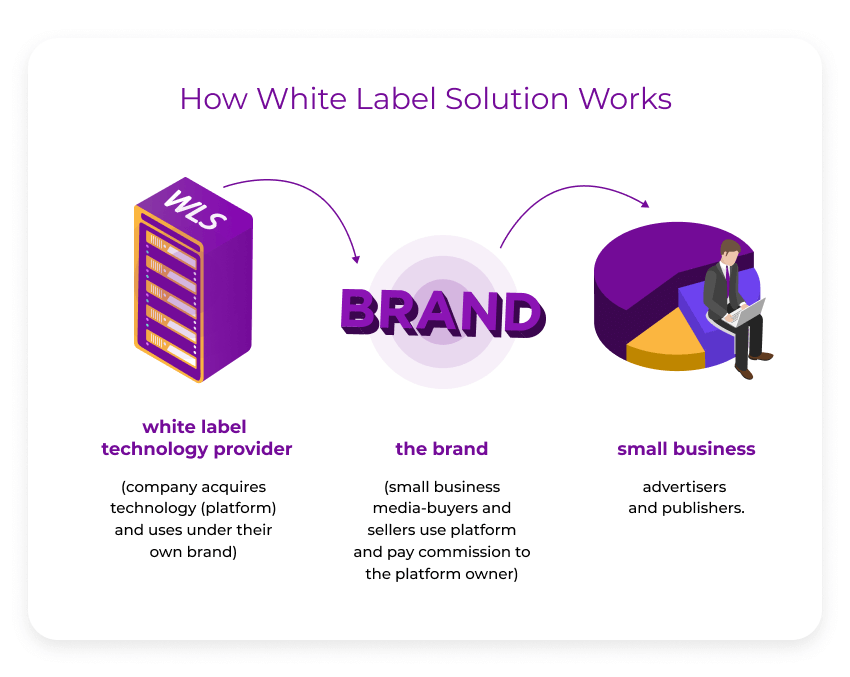
New programmatic talent
White-label developers of programmatic advertising solutions hide all of the complex processes "under the hood" of customized advertising technology that they develop for the company, be it white-label DSP, white-label ad exchange, ad network, or white-label SSP or data management platform. Such solutions like these WL ad exchanges, SSPs, and DSPs are simple and easy to understand even for non-professionals in ad tech.
The other benefit that comes with in-house advertising by default is that the platform owners define for themselves what kind of partners they want to integrate into the system. These programmatic advertising platforms are well-equipped with all kinds of traffic safety scanners but there’s nothing like an exclusive ad network of partners that guarantees transparency and certainly about media-trading outcomes.
On the stage of installation, companies can count on comprehensive onboarding, training, and all kinds of integration assistance. The only question that remains open is whether new platform owners have enough expertise of their own to make use of all capacities and serve the clients on their own.
The good news is that innovations in programmatic advertising are currently unfolding in the human resources area as well.
Big ad-tech corporations with sufficient expertise and experience in programmatic willingly share their knowledge with other companies through consulting services and by outstaffing adtech services.
Ultimately, such a model helps business owners to focus on business while the outsourced team maintains back-to-front programmatic advertising operation and client servicing: account management, tech support, ad ops, and business development.
The future of programmatic
Digital channels continuously multiply: today consumers use several gadgets before making a purchase decision. Therefore, it is important for brands to interact with customers throughout the entire user journey: on every medium, through every channel. That's is the task of programmatic advertising. Budget constraints and the rising cost of ad placements are factors that force marketers to be more accurate in assessing the impact of each ad impression.
This is why companies will gradually learn how to work effectively with big data analytics. In the near future, data analysis services will be integrated into a single programmatic advertising platform driven by AI. Plus they will be able to analyze campaigns across channels both offline and online.
As a result, such cross-platform analytic tools will help marketers make faster decisions, they will be able to build hypotheses more accurately while predicting the performance of advertising campaigns on the fly.
The last word
Programmatic advertising has been invented in order to automate the purchasing and selling of digital ad inventory. There are many reasons to turn your advertising programmatic. It helps advertisers to target only those users who can be potentially interested and thus, more likely to convert.
For the publishers, it is also very beneficial as targeted programmatic ads are less annoying to the users. On top of that, they enable publishers to receive higher yields, especially when the commission is defined by the number of clicks performed by users on the web source.
This is why gradually programmatic advertising replaces human-to-human negotiations as machine learning algorithms and artificial intelligence do a better and quicker job than humans.
The main purpose of the programmatic advertising approach is to improve the efficiency and transparency of the media trading process for both the advertiser and the publisher. Sure, you can still solve these tasks manually but is the game worth the candle when you have automated programmatic ads?
Get started with programmatic advertising solutions SmartyAds DSP for media buyers and SmartyAds SSP for media sellers.

